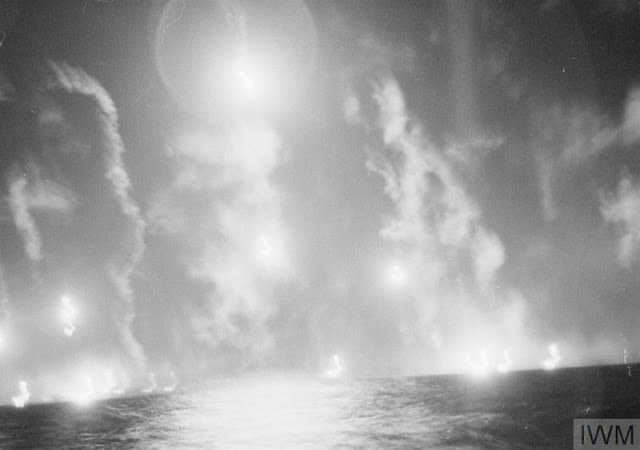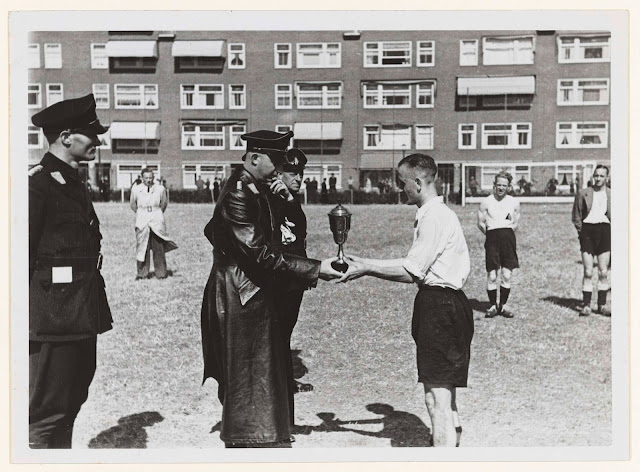Saturday 19 July 1941
 |
| Exercise Brock, 19 July 1941. This is an exercise carried out with snowflake and Type 26E flares to demonstrate the effects of illuminants at sea. © IWM (A 4633). |
In the Far North sector, Finnish Group F (part of 3rd Division) completes a successful 64 km (40 miles) advance over rugged terrain by wiping out several Soviet units on the Vyonitsa River. It now can continue advancing toward its objective of Ukhta (aka Kalevala, on Yeldanka Lake aka Ozero Verkhnyaya Yeldanka). General Dietl's Army of Norway (AOK Norwegen) now decides to shift troops (units of SS Nord Division) south from the stalled offensive near Salla and have them support the Finnish advance. The Soviets also decide to send reinforcements to the area.
In the Army Group North sector, the panzers of Panzer Group 4 continue blasting through Soviet lines towards Leningrad. The Luftwaffe attacks rail lines in an attempt to isolate Leningrad from Moscow.
In the Army Group Center sector, Hitler orders General Guderian's Panzer Group 2 south. Hitler wants to ensure the brewing victory at Kiev, where hundreds of thousands of Soviet troops appear vulnerable to being surrounded, and open the way forward to Field Marshal Rundstedt's army group. General Guderian, reflecting a broad consensus within the upper levels of the Wehrmacht, protests that it makes more sense to continue east towards Moscow. OKW confirms Hitler's order and Guderian grudgingly heads south. Hitler also orders General Hoth's Panzer Group 3 to head north to help with the attack on Leningrad (it captures Velikiye Luki during the day). This leaves Field Marshal von Bock's Army Group Center without its spearhead. Hitler never has considered Moscow to be a priority target and this decision conclusively proves that.
In the Army Group South sector, Soviet General Eremenko takes over at Soviet Western Front.
Luftwaffe Lieutenant Walter Nowotny of III./JG 54 shoots down his first enemy planes, three Polikarpov I-153 biplanes. His own aircraft is damaged and he bails out over the Gulf of Riga.
Luftwaffe losses are mounting. Total planes lost now stand at 1284.
 |
| "FLIGHT LIEUTENANT E S LOCK, DSO, DFC, AND BAR: 41 SQUADRON, RAF," 19 July 1941 (Orde, Cuthbert Julian, © IWM (Art.IWM ART LD 2363). |
In another RAF Circus raid, three Stirling bombers attack the Lille power station. One of the bombers fails to return.
After dark, RAF Bomber Command sends 49 bombers (20 Whitleys, 17 Wellingtons, 12 Hampdens) to attack the main railway station in Hannover. The RAF loses a Wellington and a Whitley. Another 35 Hampdens go on a minelaying operation at the mouth of the Elbe and Weser Rivers.
Oberst Werner Mölders of JG 51, the top ace in the war and of all-time at this point, is appointed to the newly created position of General der Jägdflieger (General of Fighters). Oblt. Friedrich Beckh replaces him in charge of JG 51.
 |
| HMS Malvernian (F 102), a tough ship that finally sinks, after being bombed on 1 July, on 19 July 1941. |
Soviet submarine L-3 torpedoes and sinks Finnish vessel Cisil.
 |
| U-553 returns to St. Nazaire from a successful patrol on 19 July 1941. Note the damaged periscope and victory pennants. |
U-66 (Kptlt. Richard Zapp), on its second patrol, torpedoes and sinks 3433-ton British freighter Holmside northeast of the Cape Verde Islands. Holmside is a straggler from Convoy OG-67, making it an independent. There are 21 deaths and 16 survivors, picked up by Portuguese freighter Sete Citades. This is U-66's last sinking on this patrol.
The RAF (No. 42 Squadron) torpedoes and sinks German escort vessel NK-08 Kanonier off Sirevåg, Norway. There are 13 deaths and 16 survivors.
Royal Navy destroyer HMS Beverly, escorting Convoy HG-68, intercepts Vichy French freighter Isac west of Gibraltar. The Isac is taken to Gibraltar for detention.
Royal Navy submarine HMS Tuna makes an attack on German ships off the Gironde in the Bay of Biscay but misses despite claiming hits.
After a lengthy journey, Norwegian tanker Ole Jacob, which was captured by German raider Atlantis on 10 November 1940, arrives at Bordeaux, France. The tanker brings aviation fuel and the crews captured on the Ole Jacob and the Teddy.
Attacked and badly damaged by the Luftwaffe on 1 July 1941 off the coast of Spain, Royal Navy armed boarding vessel HMS Malvernian is finally sunk by the Royal Navy as a hazard to navigation. Its crew, however, is still at sea - one lifeboat with 32 aboard only makes it to Corunna on 21 July, and another with 25 aboard to Vigo on 22 July. 107 other survivors have been taken POW.
US destroyer USS Baldwin and minesweeper Swallow are laid down.
U-153 (Korvettenkapitän Wilfried Reichmann) and U-375 (Kapitänleutnant Jürgen Könenkamp) are commissioned.
 |
| "An American M3 Stuart tank being hoisted from a ship onto the quayside at Alexandria, 19 July 1941." © IWM (E 4310). |
During the night, the Luftwaffe raids Alexandria and Malta while the RAF raids Tripoli and Benghazi.
Minelaying cruiser Abdiel and destroyer Abdiel make the increasingly hazardous nightly run to Tobruk from Alexandria without incident.
Battle of the Pacific: A group of 37 New Zealand coastwatchers departs from Fiji aboard ship Viti for assignments in the Gilbert and Ellice Islands. Their job is to watch for German raiders which have been seen in the area.
 |
| Natalia Bessmertnova, born on 19 July 1941 in Moscow. |
the time is approaching to carry out our coup to liberate my poor country from a weak government of completely capitalist inclinations.The letter is damning, proposing that a pro-German coup take place in mid-July. Today, after taking a day to review the letter, the government of General Penaranda declares a state of siege and decides to expel Wendler from the country. Within a week, the army dismisses Belmonte for "treason." The Bolivian government also uses the letter as a pretext to jail the leaders of, and to otherwise suppress the opposition Movimiento Nacionalista Revolucionario (MNR) party.
There is some scholarly debate about the Belmonte/Wendler letter. There is a very good likelihood that the letter was a complete fabrication by British military intelligence at Station M, a clever instance of Black Ops using the clueless U.S. government as the middleman. This is similar to the supposed letters from Mahatma Gandhi to Adolf Hitler that some historians propose are clever British forgeries (though there is no proof of that). There is no other evidence, aside from the letter, that the Germans had any intentions to launch a coup in Bolivia.
In London, Winston Churchill decides to share his Bletchley Park Ultra decrypts with the Soviets - something that he doesn't even do with the Americans. However, the source of the information will be described as Berlin spies rather than intelligence intercepts.
In Afghanistan, two German Abwehr agents are identified as attempting to enter India. Afghan police arrest one and kill the other.
Partisans: The uprising in Montenegro that began on 13 July continues. The partisans remain on the offensive and are planning to take over several more Montenegran towns.
 |
| Winston Churchill flashes the "V for Victory" sign. |
Events are taking place that are of great significance in this war. The importance of these events will probably not be realized for a long time, and, in fact, the events themselves are not likely to be noticed. But it's in connection with them that I asked you a week ago to start a "V" campaign - V's in sight and sound - which would work up to a climax tomorrow, July 20. Now I want to tell you what should be your contribution to making July 20 one of the milestones in the war.
July 20 is the date of Europe's mobilization against the Germans. Tomorrow the V Army - Europe's invisible army of many millions - will come into being. You're listening to me now in your home. Thousands and thousands of others are listening too.
The mobilization will begin at midnight 24 hours from now, and it will continue throughout the day. You are eligible to join the V Army, and I ask you to join.He concludes that "In a few minutes there will be millions of new ‘Vs’ on walls and doors and pavements all over Europe."
Colonel Britton is the pseudonym of Douglas Ritchie, a 36-year-old Assistant News Editor at the BBC. The BBC has foreshadowed this campaign by prefacing its programs with the Morse Code for "V" (...- - -) for some time. To give proper credit, the instigator for the "V" campaign was a Belgian refugee named Victor de Laveleye, who made short-wave broadcasts from London to his native Belgium in early 1941 asking Belgians to chalk the letter V (for victoire) in public places as a sign of confidence in eventual Allied victory. Ritchie's broadcasts expand the idea to all of Occupied Europe.
 |
| Five Royal Canadian Air Force Cessna Cranes overfly a sixth on the opening day of No. 12 Service Flying Training School on July 19, 1941, at Brandon, Manitoba. PHOTO: DND Archives, PL-5747. |
German/Swedish Relations: In Sweden, which has pursued a policy of neutrality through two World Wars, has a significant faction that believes the country should help Germany defeat the Soviet Union. General Olof Thörnell, commander of Swedish forces, proposes that Sweden contribute some troops to the effort like Spain and its Blue Division. This proposal is not acted upon.
Japanese/US Relations: The Japanese have been considering what to do about American Presbyterian missionaries in Korea. Up to this date, the Japanese have demanded that the missionaries leave Korea, who are accused of distributing dangerous literature. Having now concluded from discussions with the church representatives that they are not going to leave Korea, Ambassador Nomura recommends that a conference be held with the missionaries and otherwise dropped as a gesture of goodwill.
Japanese/Vichy French Relations: The Japanese demand more access to bases in southern Indochina.
US/Chinese Relations: Owen Lattimore arrives in Chungking as a military advisor.
 |
| Sportsmen in Amsterdam give the NSB greeting in competitions organized by the WA. |
US Military: USS Wasp (CV 7) flies a cargo of P-40 fighters to Iceland.
Task Force 1 is formed within the Atlantic Fleet for protection of US forces in Iceland and convoys heading there.
The first 13 pilots join the segregated Civilian Pilot Training Program at the Tuskegee Institute in Alabama. These are the initial Tuskegee Airmen.
British Government: Prime Minister Winston Churchill makes some appointments: Brendan Bracken, Minister of Information; R. A. Butler, President of Board of Education; Lord Hankey, Paymaster-General; Duncan Sandys, Financial Secretary to War Office.
 |
| Clay Hotel, Washington Ave., Miami Beach. July 1941. ORIGINAL CAPTION: "Washington Boulevard, a shopping district in Miami Beach, Florida." (Library of Congress). |
Einsatzcommando 3 of Einsatzgruppe A execute 27 people at Kaunas Seventh Fort: 17 Jewish men, 2 Jewish women, and 7 non-Jews.
American Homefront: United States Senator from North Dakota Gerald P. Nye gives a speech over the NBC Red Network in which he expresses his isolationist sentiments. Nye says that there is no reason to "go hunting" for a war. He begins his speech:
It may seem ages ago that America was quite unanimous, and vociferous, in its cry of "Never Again," meaning there would be no toleration of effort to move our country into another European. But it was really only two years ago when memories of our last experience in Europe were still sufficiently clear to let us see what folly it would be to let ourselves be taken again into the wringer across the Atlantic.He warns against allowing the military and President Roosevelt to "ignore the restrictions written by Congress as to where our boys shall and shall not be sent, without a declaration of war by Congress."
"Arizona Bound" is released. Directed by Spencer Gordon Bennet and starring Buck Jones and Tim McCoy, it follows the adventures of a retired Federal Marshal who takes a job driving a stagecoach full of gold and is accused of stealing it after it is robbed.
Future History: Florencia Bisenta de Casillas-Martinez Cardona is born in El Paso, Texas. In the early 1960s, she adopts the stage name "Vicki Carr." As Carr, she signs with Liberty Records in 1962 and has a minor hit single with "He's A Rebel." She goes on to a very successful run during the 1960s that includes ten singles and 13 albums on the pop charts. In the 1980s onward, Carr focuses more on recording Latin music. Carr continues to record as of 2018.
Natalia Bessmertnova is born in Moscow. In 1963, Bessmertnova joins the Bolshoi Ballet. She becomes the Soviet prima ballerina of the Bolshoi Ballet for three decades and a People's Artist of the USSR. She later becomes famous across the world in 1995 for leading a strike of the Ballet that leads to the cancellation of scheduled performances following the firing of Yury Grigorovich. Natalia passes away in 2008.
July 1941
July 1, 1941: US TV Broadcasting Starts
July 2, 1941: MAUD Report
July 3, 1941: Stalin Speaks
July 4, 1941: Pogroms in Eastern Europe
July 5, 1941: Germans on Schedule
July 6, 1941: Australians Attack Damour
July 7, 1941: US Marines in Iceland
July 8, 1941: Flying Fortresses In Action
July 9, 1941: British Take Damour
July 10, 1941: Sword and Scabbard Order
July 11, 1941: Cease-fire in Syria and Lebanon
July 12, 1941: Anglo/Russian Assistance Pact
July 13, 1941: Uprising in Montenegro
July 14, 1941: Katyusha Rocket Launchers in Action
July 15, 1941: Smolensk Falls
July 16, 1941: Stalin's Son Captured
July 17, 1941: Heydrich Orders Mass Executions
July 18, 1941: Twin Pimples Raid
July 19, 1941: V for Victory
July 20, 1941: The Man Who Wouldn't Shoot
July 21, 1941: Moscow in Flames
July 22, 1941: Soviet Generals Executed
July 23, 1941: Secret Plan JB 355
July 24, 1941: Operation Sunrise
July 25, 1941: US Naval Alert
July 26, 1941: Italian E-Boat Attack on Malta
July 27, 1941: MacArthur Returns
July 28, 1941: Auschwitz Exterminations
July 29, 1941: Rescue From Crete
July 30, 1941: Raid on Petsamo and Kirkenes
July 31, 1941: Final Solution Order
2020

No comments:
Post a Comment